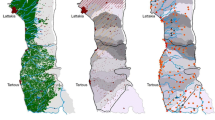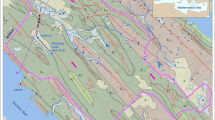Abstract
Protection against flooding by the sea, drainage of rainwater and integrated management of groundwater and surface-water resources are key issues in low-lying coastal areas. However, under exceptional circumstances, knowledge to keep coastal areas dry and habitable can be used otherwise. Inundation for military purposes is such an example. The hydrogeology of the inundation at the Yser River, Belgium, during the Great War is studied. The inundation started in October 1914 to stop the German advance and lasted until 1918. A water balance and groundwater model are combined to derive the water balance before and during the inundation and to study the impact on the groundwater system. It is concluded that a number of hydrogeological factors contributed to the effectiveness of the inundation. Most importantly, the low-permeability subsoil facilitated loss of inundation water mainly by evaporation. Further, the normal water management strategy of the area (aimed at evacuating excess water towards the sea) was reversed to keep water between the opposing armies. However, the duration of the inundation meant a reorganization of the drainage of areas not inundated; truly an exercise in integrated water management.
Résumé
La protection contre la submersion marine, le drainage de l’eau de pluie et la gestion intégrée des ressources en eau souterraines et de surface sont des dispositions essentielles dans les zones côtières basses. Toutefois, dans des circonstances exceptionnelles, la connaissance des dispositions pour maintenir les zones côtières hors d’eau et habitables peut être utilisée autrement. L’inondation à des fins militaires est un tel exemple. L’hydrogéologie de l’inondation par la rivière Yser, Belgique, durant la Grande Guerre est étudiée. L’inondation débuta en octobre 1914 pour ralentir l’avance allemande et dura jusqu’en 1918. Un bilan d’eau et un modèle hydrogéologique sont combinés pour établir les bilans d’eau avant et durant l’inondation et pour étudier son impact sur le système aquifère. Il a été conclu que plusieurs facteurs hydrogéologiques ont contribué à rendre l’inondation effective. Pour une grande part, la faible perméabilité de la sub-surface a entraîné la perte d’eau d’inondation principalement par évaporation. De plus, la stratégie de gestion normale de l’eau dans la zone (sensée évacuer l’excédent d’eau vers la mer) a été inversée pour conserver l’eau entre les armées adverses. Cependant, la durée de l’inondation signifiait la réorganisation des aires de drainages non inondées; véritablement un exercice de gestion intégrée de l’eau.
Resumen
Las protecciones contra la inundación a orillas del mar, el drenaje del agua de lluvia y la gestión integrada de los recursos hídricos subterráneas y superficiales son temas claves en las áreas costeras bajas. Sin embargo, en circunstancias excepcionales, el conocimiento para mantener las zonas costeras secas y habitables puede ser utilizado de otra manera. La inundación voluntaria para fines militares es un ejemplo. Se estudia la hidrogeología de la inundación en el río Yser, Bélgica, durante la Primera Guerra. La inundación se inició en octubre de 1914 para detener el avance alemán y duró hasta 1918. Un balance hídrico y un modelo de agua subterránea se combinan para obtener el balance de agua antes y durante la inundación y para estudiar el impacto sobre el sistema de agua subterránea. Se concluye que una serie de factores hidrogeológicos contribuyó a la eficacia de la inundación. El más importante, es la baja permeabilidad del subsuelo de facilitó la pérdida del agua de la inundación principalmente por evaporación. Además, la estrategia de gestión del agua habitual de la zona (destinado a evacuar el exceso de agua hacia el mar) se invirtió para mantener el agua entre los ejércitos enemigos. Sin embargo, la duración de la inundación significó una reorganización del drenaje de las zonas no inundadas, verdaderamente un ejercicio de la gestión integrada del agua.
摘要
防海水淹没、雨水排泄和地下水和地表水资源的综合管理是低洼沿海地区的关键问题。然而,在特殊情况下,保持沿海地区干燥及可居住的知识可以在用在其他方面。军事目的的洪水淹没就是这样的例子。本文研究了世界大战期间比利时伊瑟河前缘被淹没时的水文地质状况。洪水淹没始于1914年10月,以阻止德军的前进步伐,一直持续到1918年。水平衡模型和地下水模型结合起来得出了淹没前和淹没期间的水平衡状况,并且研究了对地下水系统的影响。结论是,许多水文地质因素对淹没的效果产生影响。最重要的是,低渗透性下层土促进了洪水的损耗,损耗主要是蒸发。此外,本地区正常的水管理战略(目的是向海里排放多余的水)被颠倒,以在两军之间保持有水。然而,洪水淹没的持续时间意味着未被淹没地区排水的重新组织;这真是综合水管理的一个实践。
Resumo
Proteção contra inundações pelo mar, drenagem de água da chuva e gestão integrada de recursos hídricos superficiais e subterrâneos são questões chave em áreas costeiras de baixa altitude. Entretanto, sob circunstâncias excepcionais, o conhecimento de manter áreas costeiras secas e habitáveis pode ser utilizado de outra forma. Inundação para fins militares é um exemplo. Nesse trabalho, estudou-se a hidrogeologia da inundação no Rio Yser, Bélgica, durante a Primeira Guerra Mundial. A inundação começou em Outubro de 1914 para conter o avanço alemão e permaneceu até 1918. Um balanço hídrico e um modelo de águas subterrâneas são combinados para extrair o balanço hídrico antes e durante a inundação, e para estudar seu impacto no sistema de águas subterrâneas. Conclui-se que uma gama de fatores hidrogeológicos contribuiu para a efetividade da inundação. Mais importante, o subsolo de baixa permeabilidade facilitou a perda de água de inundação principalmente por evaporação. Além disso, a estratégia normal de gestão da água na área (destinada a escoar a água em excesso em direção ao mar) foi revertida para manter a água entre os exércitos opostos. Entretanto, a duração da inundação significou uma reorganização da drenagem em áreas não inundadas; um verdadeiro exercício de gestão integrada da água.











Similar content being viewed by others
References
Baeteman C (2008) De Holocene geologie van de Belgische kustvlakte [The Holocene geology of the Belgian coastal plain]. Geol Surv Belgium Prof Pap 2008/2-N.304, Geological Survey Belgium, Brussels
Bauwens J (2008) De IJzer. Het ultieme front [The Yser River: the ultimate front]. Davidsfonds, Leuven, The Netherlands
Brooks RH, Corey AT (1966) Properties of porous media affecting fluid flow. ASCE J lrrig Drain 101:85–92
Cloke HL, Pappenberger F (2009) Ensemble flood forecasting: a review. J Hydrol 375(3–4):613–626. doi:10.1016/j.jhydrol.2009.06.005
De Breuck W, De Moor G, Maréchal R, Tavernier R (1974) Diepte van het grensvlak tussen zoet en zout water in de freatische laag van het Belgische kustgebied (1963–1973). Verziltingskaart [Depth of the fresh-salt water interface in the phreatic aquifer of the Belgian coastal plain (1963–1973). Salinisation map],s Militair Geografisch Instituut, Brussels
De Kraker AMJ (2006) Flood events in the southwestern Netherlands and coastal Belgium, 1400–1953. Hydrol Sci J 51(5):913–929. doi:10.1623/hysj.51.5.913
Greggio N, Mollema P, Antonellini M, Gabbianelli G (2012) Irrigation management in coastal zones to prevent soil and groundwater salinization. In: Abrol V, Peeyush S (eds) Resource management for sustainable agriculture. Intech, Rijeka, Croatia. doi:10.5772/50534
Harbaugh AW, Banta ER, Hill MC, McDonald MG (2000) MODFLOW-2000, the U.S. geological survey modular ground-water model: user guide to modularization concepts and the ground-water process. US Geol Surv Open-File Rep 00–92
Kjeldsena TR, Macdonaldb N, Langc M, Medierod L, Albuquerquee T, Bogdanowiczf E, Brázdilg R, Castellarinh A, Davidi V, Fleigj A, Gülk GO, Kriauciunienel J, Kohnovám S, Merzn B, Nicholsono O, Roaldj LA, Salinasp JL, Sarauskienel D, Srajq M, Strupczewskir W, Szolgaym J, Toumaziss A, Vanneuvillet W, Veijalainenu N, Wilsonj D (2014) Documentary evidence of past floods in Europe and their utility in flood frequency estimation. J Hydrol 517:963–973. doi:10.1016/j.jhydrol.2014.06.038
Langevin CD, Thorne DT, Dausman AM, Sukop MC, Guo W (2007) SEAWAT version 4: a computer program for simulation of multi-species solute and heat transport. US Geol Surv Tech. Methods Book 6, chap. A22, US Geological Survey, Reston, VA
Leper J (1957) Kunstmatige inundaties in maritiem Vlaanderen [Artificial inundations in maritime Flanders]. Michiels, Tongeren, Belgium
Massart J (1920) La biologie des inondations de l’Yser et la flore des ruines de Nieuport (Biology of the inundations at the Yser River and the flora at the ruines of Nieuwpoort). Recueil de l’Institut botanique Léo Errera 10:411–430
Monteith JL (1965) Evaporation and environment. In: Fogg GE (ed) The state and movement of water in living organism. 19th Symp. Soc. Exptl. Biology, Swansea UK, September 1964, University Press, Cambridge, UK, pp 205–234
Oude Essink GHP, van Baaren ES, de Louw PGB (2010) Effects of climate change on coastal groundwater systems: a modeling study in the Netherlands. Water Resour Res 46:W00F04. doi:10.1029/2009WR008719
Stuyfzand PJ, Stuurman RJ (2008) Origin, distribution and chemical mass balances of non-anthropogenic, brackish and (hyper) saline ground waters in the Netherlands. In: Barrocu G (ed) Proc. 1st SWIM-SWICA Joint Saltwater Intrusion Conference, Cagliari, Italy, 2006, pp 151–164
Thys R (1922) Nieuport 1914–1918. Les inondations de l’Yser et la Compagnie des Sapeurs-Pontonniers du Génie Belge [Nieuwpoort 1914–1918: the inundations at the Yser River and the Belgian engineering corps]. Desoer, Liège, Belgium
Van Biersel TP, Carlson DA, Milner LR (2007) Impact of hurricanes storm surges on the groundwater resources. Environ Geol 53:813–826. doi:10.1007/s00254-007-0694-x
Vandenbohede A, Lebbe L (2012) Groundwater chemistry patterns in the phreatic aquifer of the central Belgian coastal plain. Appl Geochem 27:22–36
Van der Wee X (2012) Hydraulische studie naar de onderwaterzetting van de IJzervlakte tijdens WOI [Hydraulic study of the inundation of the Yser during WOI]. MSc Thesis, Katholieke Universiteit Leuven, The Netherlands
Van Pul P (2006) In Flanders flooded fields: before Ypres there was Yser. Pen and Swords, Barnsley, UK
Van Pul P (2014) De Belgische militaire onderwatzettingen rond de Versterte Plaats van Antwerpen in augustus en september 1914. Een historisch-geografische reconstructie [The Belgian military inundations around the antwerp fortified place in august and September 1914: a historic-geographical reconstruction]. Waterbouwkundig Laboratorium, Antwerpen-Borgerhout, Belgium
Vandenbohede A, Lebbe L (2002) Numerical modelling and hydrochemical characterisation of a fresh water lens in the Belgian coastal plain. Hydrogeol J 10(5):576–586. doi:10.1007/s10040-002-0209-5
Vandenbohede A, Courtens C, Lebbe L, De Breuck W (2010) Fresh–salt water distribution in the central Belgian coastal plain: an update. Geol Belg 13(3):163–172, URL: http://popups.ulg.ac.be/1374-8505/index.php?id=2915
Vandenbohede A, Hinsby K, Courtens C, Lebbe L (2011) Flow and transport model of a polder area in the Belgian coastal plain: example of data integration. Hydrogeol J 19(8):1599–1615. doi:10.1007/s10040-011-0781-7
Vandenbohede A, Walraevens K, De Breuck W (2015) What does the interface on the fresh–saltwater distribution map of the Belgian coastal plain represent? Geol Belg 18(1):31–36, URL: http://popups.ulg.ac.be/1374-8505/index.php?id=4992
Vandenbohede A (2014) Quartair van de Kustvlakte en polders van de Westerschelde [Quaternary of the coastal plain and western Schelde River]. In: Dassargues A, Walraevens K (eds) Watervoerende lagen en grondwater in België / Aquifères et eaux souterraines en Belgique [Aquifers and groundwater in Belgium]. Academia, Gent, Belgium, pp 5–15
Vithanage M, Engesgaard P, Villholth KG, Jensen KH (2012) The effects of the 2004 tsunami on a coastal aquifer in Sri Lanka. Ground Water 50(5):704–714. doi:10.1111/j.1745-6584.2011.00893.x
Wang ZM, Batelaan O, De Smedt F (1996) A distributed model for water and energy transfer between soil, plants and atmosphere (WetSpa). Phys Chem Earth 21(3):189–193. doi:10.1016/S0079-1946(97)85583-8
Zheng C, Wang PP (1999) MT3DMS, a modular three-dimensional multispecies model for simulation of advection, dispersion and chemical reactions of contaminants in groundwater systems: documentation and user’s guide. US Army Engineer Research and Development Center contract report SERDP-99-1, USAERDC, Vicksburg, MI
Acknowledgements
I thank Paul Van Pul for the enthusiastic sharing of his knowledge on historic and technical aspects of the Yser inundation and for proofreading the manuscript. Sara Eeman and two anonymous reviewers are thanked for their constructive reviews.
Author information
Authors and Affiliations
Corresponding author
Electronic supplementary material
Below is the link to the electronic supplementary material.
ESM 1
(PDF 539 kb)
Rights and permissions
About this article
Cite this article
Vandenbohede, A. The hydrogeology of the military inundation at the 1914–1918 Yser front (Belgium). Hydrogeol J 24, 521–534 (2016). https://doi.org/10.1007/s10040-015-1344-0
Received:
Accepted:
Published:
Issue Date:
DOI: https://doi.org/10.1007/s10040-015-1344-0




